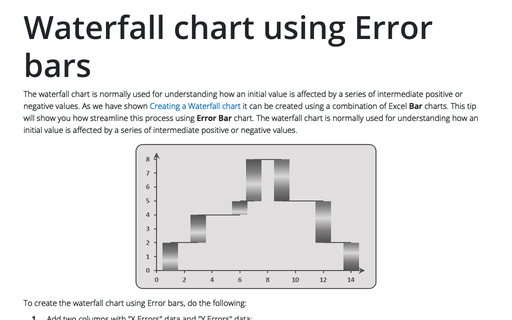Creating a glossy thermometer chart

The trick involves creating a chart that uses a single cell (which holds a percentage value) as a data
series.

For example, a worksheet set up to track monthly progress toward a goal: 1,000 new sales in a year period. Cell B16 contains the goal value, and cell B18 contains a simple sum formula:
= SUM (B4:B15)
Cell B20 contains a formula that calculates the percent of goal:
= B18 / B16
As you enter new data in column B, the formulas display the current results.
To create the chart like this one, do the following:
1. Select cell B18, click the Chart Wizard ![]() button (or choose Insert -> Chart...).
button (or choose Insert -> Chart...).
Notice the blank row before cell B18. Without this blank row, Excel uses the entire data block for the chart, not just the single cell. Because B18 is isolated from the other data, the Chart Wizard uses only the single cell.
2. In the Chart Wizard dialog box, choose a Column type and the Clustered Column sub-type and then click the Next > button:

For a quick preview of the chart you are creating, click Press and Hold to View Sample.
3. On the Step 2 of the Chart Wizard, check the data and click the Next > button.
4. On the Step 3 of the Chart Wizard:
- Remove or change the chart title on the Titles tab
- Uncheck the Category (x) axis on the Axes tab to removes the category axis from the chart.
- Remove Major gridlines on the Gridlines tab
- Remove the legend on the Legend tab.

5. On the Step 4 of Chart Wizard, click the Finish button:
6. To make the column occupy the entire width of the plot area, double-click the column to display the Format Data Series dialog box. Then select the Options tab, and change the Gap Width setting.

Set the Gap width to 0.
7. Double-click the value axis to access the Format Axis dialog box:
In the Format Axis dialog box, on the Scale tab, set the Minimum to 0 and the Maximum to 1 (if you use a percentage axis) or to 1000 (for this example):

You can also hide the zero point in the axis (see How to hide points on the chart axis) and the axis line.
8. Click the AutoShapes ![]() button (or choose Insert -> Picture
-> AutoShapes).
button (or choose Insert -> Picture
-> AutoShapes).
9. On the AutoShapes toolbar, in the Basic Shapes group, choose Oval:

10. Format the shape and insert the data label (see How to insert cell content to the shape).
You can then make any other adjustments to get the look you desire.


